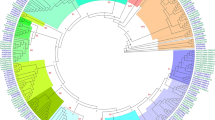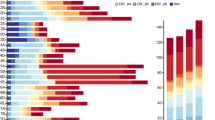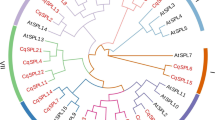Abstract
AP2/ERF transcription factors are primarily found in plants and play a crucial role in regulating various biological and physiological processes. These processes include plant morphogenesis, response to stresses, hormone signaling, and metabolite biosynthesis. While the AP2/ERF genes in Arabidopsis (Arabidopsis thaliana), wheat (Triticum aestivum), rice (Oryza sativa), and barley (Hordeum vulgare) have been extensively studied, there has been a lack of systematic investigation into the AP2/ERF genes in quinoa (Chenopodium quinoa). Therefore, this study aimed to identify and characterize the AP2/ERF genes in quinoa on a genome-wide scale. A total of 105 CqAP2/ERF genes were identified, and phylogenetic analysis revealed that these genes could be classified into 5 different subfamilies. The evolutionary analysis indicated that CqAP2/ERF gene existed before the evolution of dicotyledons, and genetic variation occurred during the evolution from dicotyledons to monocotyledons. Furthermore, these genes were subjected to purifying selection during evolution. Expression analysis demonstrated that most CqAP2/ERF genes exhibited distinct expression patterns in different tissues and developmental stages. Additionally, five CqAP2/ERF genes were found to be responsive to various stimuli, such as drought, high temperature, salt, and low phosphorus. These findings highlight the importance of CqAP2/ERF genes in quinoa development and their involvement in multiple signaling pathways. The comprehensive understanding of CqAP2/ERFs obtained from this study provides valuable insights for further functional characterization and potential applications in quinoa research.









Similar content being viewed by others
Data Availability
Data sharing is not applicable to this article as no datasets were generated or analyzed during the current study.
References
Alonso JM (2003) Genome-wide insertional mutagenesis of Arabidopsis thaliana. Science 301(5641):1849–1849
Aukerman MJ, Sakai H (2003) Regulation of flowering time and floral organ identity by a microRNA and its APETALA2-like target genes. Plant Cell 15(11):2730–2741. https://doi.org/10.1105/tpc.016238
Bowers JE, Chapman BA, Rong JK, Paterson AH (2003) Unravelling angiosperm genome evolution by phylogenetic analysis of chromosomal duplication events. Nature 422(6930):433–438. https://doi.org/10.1038/nature01521
Cao SL, Wang Y, Li XT, Gao F, Feng JC, Zhou YJ (2020) Characterization of the AP2/ERF transcription factor family and expression profiling of DREB subfamily under cold and osmotic stresses in Ammopiptanthus nanus. Plants-Basel. https://doi.org/10.3390/plants9040455
Chen C, Wu Y, Li J, Wang X, Zeng Z, Xu J, Liu Y, Feng J, Chen H, He Y, Xia R (2023) TBtools-II: a “One for All, All for One” bioinformatics platform for biological big-data mining. Mol Plant. https://doi.org/10.1016/j.molp.2023.09.010
Cheng C, An LK, Li FZ, Ahmad W, Aslam M, Ul Haq MZ, Yan YX, Ahmad RM (2023) Wide-range portrayal of AP2/ERF transcription factor family in maize (Zea mays L.) development and stress responses. Genes. https://doi.org/10.3390/genes14010194
Couee I, Gouesbet G (2023) Protein-protein interactions in abiotic stress signaling: an overview of biochemical and biophysical methods of characterization. Methods Mol Biol (Clifton, NJ) 2642:319–330. https://doi.org/10.1007/978-1-0716-3044-0_17
Faraji S, Filiz E, Kazemitabar SK, Vannozzi A, Palumbo F, Barcaccia G, Heidari P (2020) The AP2/ERF gene family in Triticum durum: genome-wide identification and expression analysis under drought and salinity stresses. Genes. https://doi.org/10.3390/genes11121464
Feng K, Hou XL, Xing GM, Liu JX, Duan AQ, Xu ZS, Li MY, Zhuang J, Xiong AS (2020) Advances in AP2/ERF super-family transcription factors in plant. Crit Rev Biotechnol 40(6):750–776. https://doi.org/10.1080/07388551.2020.1768509
Gu ZL, Steinmetz LM, Gu X, Scharfe C, Davis RW, Li WH (2003) Role of duplicate genes in genetic robustness against null mutations. Nature 421(6918):63–66. https://doi.org/10.1038/nature01198
Gu C, Guo ZH, Hao PP, Wang GM, Jin ZM, Zhang SL (2017) Multiple regulatory roles of AP2/ERF transcription factor in angiosperm. Bot Stud. https://doi.org/10.1186/s40529-016-0159-1
Han H, Krizek BA (2016) AINTEGUMENTA-like6 can functionally replace AINTEGUMENTA but alters Arabidopsis flower development when misexpressed at high levels. Plant Mol Biol 92(4–5):597–612. https://doi.org/10.1007/s11103-016-0535-y
Hassan S, Berk K, Aronsson H (2022) Evolution and identification of DREB transcription factors in the wheat genome: modeling, docking and simulation of DREB proteins associated with salt stress. J Biomol Struct Dyn 40(16):7191–7204. https://doi.org/10.1080/07391102.2021.1894980
Hu YX, Wang YH, Liu XF, Li JY (2004) Arabidopsis RAV1 is down-regulated by brassinosteroid and may act as a negative regulator during plant development. Cell Res 14(1):8–15. https://doi.org/10.1038/sj.cr.7290197
Huang Z, Zhong XJ, He J, Jiang MY, Yu XF, Li X (2016) Identification and characterization of AP2/ERF transcription factors in moso bamboo (Phyllostachys edulis). Mol Biol 50(5):693–704. https://doi.org/10.1134/s002689331605006x
Illgen S, Zintl S, Zuther E, Hincha DK, Schmulling T (2020) Characterisation of the ERF102 to ERF105 genes of Arabidopsis thaliana and their role in the response to cold stress. Plant Mol Biol 103(3):303–320. https://doi.org/10.1007/s11103-020-00993-1
Jarambasa T, Regon P, Jyoti SY, Gupta D, Panda SK, Tanti B (2023) Genome-wide identification and expression analysis of the Pisum sativum (L.) APETALA2/ethylene-responsive factor (AP2/ERF) gene family reveals functions in drought and cold stresses. Genetica 151(3):225–239. https://doi.org/10.1007/s10709-023-00190-0
Jarvis DE, Ho YS, Lightfoot DJ, Schmockel SM, Li B, Borm TJA, Ohyanagi H, Mineta K, Michell CT, Saber N, Kharbatia NM, Rupper RR, Sharp AR, Dally N, Boughton BA, Woo YH, Gao G, Schijlen E, Guo XJ, Momin AA, Negrao S, Al-Babili S, Gehring C, Roessner U, Jung C, Murphy K, Arold ST, Gojobori T, van der Linden CG, van Loo EN, Jellen EN, Maughan PJ, Tester M (2017) The genome of Chenopodium quinoa. Nature 545(7655):510–510. https://doi.org/10.1038/nature22384
Jofuku KD, Omidyar PK, Gee Z, Okamuro JK (2005) Control of seed mass and seed yield by the floral homeotic gene APETALA2. PNAS 102(8):3117–3122. https://doi.org/10.1073/pnas.0409893102
Kavas M, Kizildogan AK, Gokdemir G, Baloglu MC (2015) Genome-wide investigation and expression analysis of AP2-ERF gene family in salt tolerant common bean. EXCLI J 14:1187–1206
Koyama T, Sato F (2018) The function of ETHYLENE RESPONSE FACTOR genes in the light-induced anthocyanin production of Arabidopsis thaliana leaves. Plant Biotechnology 35(1):87–91. https://doi.org/10.5511/plantbiotechnology.18.0122b
Latini A, Rasi C, Sperandei M, Cantale C, Iannetta M, Dettori M, Ammar K, Galeffi P (2007) Identification of a DREB-related gene in Triticum durum and its expression under water stress conditions. Ann Appl Biol 150(2):187–195. https://doi.org/10.1111/j.1744-7348.2007.00128.x
Latini A, Sperandei M, Cantale C, Arcangeli C, Ammar K, Galeffi P (2013) Variability and expression profile of the DRF1 gene in four cultivars of durum wheat and one triticale under moderate water stress conditions. Planta 237(4):967–978. https://doi.org/10.1007/s00425-012-1816-6
Li DF, Zhang YQ, Hu XN, Shen XY, Ma L, Su Z, Wang T, Dong JL (2011) Transcriptional profiling of Medicago truncatula under salt stress identified a novel CBF transcription factor MtCBF4 that plays an important role in abiotic stress responses. BMC Plant Biol. https://doi.org/10.1186/1471-2229-11-109
Liu JH, Peng T, Dai WS (2014) Critical cis-acting elements and interacting transcription factors: key players associated with abiotic stress responses in plants. Plant Mol Biol Report 32(2):303–317. https://doi.org/10.1007/s11105-013-0667-z
Magar MM, Liu H, Yan GJ (2022) Genome-wide analysis of AP2/ERF superfamily genes in contrasting wheat genotypes reveals heat stress-related candidate genes. Front Plant Sci. https://doi.org/10.3389/fpls.2022.853086
Makhloufi E, Yousfi FE, Marande W, Mila I, Hanana M, Berges H, Mzid R, Bouzayen M (2014) Isolation and molecular characterization of ERF1, an ethylene response factor gene from durum wheat (Triticum turgidum L. subsp durum), potentially involved in salt-stress responses. J Exp Bot 65(22):6359–6371. https://doi.org/10.1093/jxb/eru352
Mathur S, Priyadarshini SS, Singh V, Vashisht I, Jung KH, Sharma R, Sharma MK (2020) Comprehensive phylogenomic analysis of ERF genes in sorghum provides clues to the evolution of gene functions and redundancy among gene family members. 3 Biotech. https://doi.org/10.1007/s13205-020-2120-y
Moore RC, Purugganan MD (2005) The evolutionary dynamics of plant duplicate genes. Curr Opin Plant Biol 8(2):122–128. https://doi.org/10.1016/j.pbi.2004.12.001
Ohto MA, Floyd SK, Fischer RL, Goldberg RB, Harada JJ (2009) Effects of APETALA2 on embryo, endosperm, and seed coat development determine seed size in Arabidopsis. Sex Plant Reprod 22(4):277–289. https://doi.org/10.1007/s00497-009-0116-1
Onate-Sanchez L, Anderson JP, Young J, Singh KB (2007) AtERF14, a member of the ERF family of transcription factors, plays a nonredundant role in plant defense. Plant Physiol 143(1):400–409. https://doi.org/10.1104/pp.106.086637
Qin F, Kakimoto M, Sakuma Y, Maruyama K, Osakabe Y, Tran LSP, Shinozaki K, Yamaguchi-Shinozaki K (2007) Regulation and functional analysis of ZmDREB2A in response to drought and heat stresses in Zea mays L. Plant J 50(1):54–69. https://doi.org/10.1111/j.1365-313X.2007.03034.x
Rane J, Singh AK, Kumar M, Boraiah KM, Meena KK, Pradhan A, Prasad PVV (2021) The adaptation and tolerance of major cereals and legumes to important abiotic stresses. Int J Mol Sci. https://doi.org/10.3390/ijms222312970
Rehman S, Mahmood T (2015) Functional role of DREB and ERF transcription factors: regulating stress-responsive network in plants. Acta Physiol Plant. https://doi.org/10.1007/s11738-015-1929-1
Sakuma Y, Maruyama K, Qin F, Osakabe Y, Shinozaki K, Yamaguchi-Shinozaki K (2006) Dual function of an Arabidopsis transcription factor DREB2A in water-stress-responsive and heat-stress-responsive gene expression. PNAS 103(49):18822–18827. https://doi.org/10.1073/pnas.0605639103
Sazegari S, Niazi A, Ahmadi FS (2015) A study on the regulatory network with promoter analysis for Arabidopsis DREB-genes. Bioinformation 11(2):101–106. https://doi.org/10.6026/97320630011101
Sharma MK, Kumar R, Solanke AU, Sharma R, Tyagi AK, Sharma AK (2010) Identification, phylogeny, and transcript profiling of ERF family genes during development and abiotic stress treatments in tomato. Mol Genet Genomics 284(6):455–475. https://doi.org/10.1007/s00438-010-0580-1
Sohn KH, Lee SC, Jung HW, Hong JK, Hwang BK (2006) Expression and functional roles of the pepper pathogen-induced transcription factor RAV1 in bacterial disease resistance, and drought and salt stress tolerance. Plant Mol Biol 61(6):897–915. https://doi.org/10.1007/s11103-006-0057-0
Su YL, Ma ZH, Mao J, Li WF, Cao XJ, Chen BH (2022) Genome-wide identification and characterization of the strawberry (Fragaria Vesca) FvAP2/ERF gene family in abiotic stress. Plant Mol Biol Report 40(4):646–660. https://doi.org/10.1007/s11105-022-01343-9
Taketa S, Amano S, Tsujino Y, Sato T, Saisho D, Kakeda K, Nomura M, Suzuki T, Matsumoto T, Sato K, Kanamori H, Kawasaki S, Takeda K (2008) Barley grain with adhering hulls is controlled by an ERF family transcription factor gene regulating a lipid biosynthesis pathway. PNAS 105(10):4062–4067. https://doi.org/10.1073/pnas.0711034105
Wan R, Song JH, Lv ZY, Qi XC, Han XM, Guo Q, Wang S, Shi JL, Jian ZH, Hu QX, Chen YH (2022) Genome-wide identification and comprehensive analysis of the AP2/ERF gene family in pomegranate fruit development and postharvest preservation. Genes. https://doi.org/10.3390/genes13050895
Wang HT, Ni DQ, Shen JC, Deng SS, Xuan HD, Wang CC, Xu JY, Zhou L, Guo N, Zhao JM, Xing H (2022) Genome-wide identification of the AP2/ERF gene family and functional analysis of GmAP2/ERF144 for drought tolerance in soybean. Front Plant Sci. https://doi.org/10.3389/fpls.2022.848766
Wessler SR (2005) Homing into the origin of the AP2 DNA binding domain. Trends Plant Sci 10(2):54–56. https://doi.org/10.1016/j.tplants.2004.12.007
Xu W, Li F, Ling LZ, Liu AZ (2013) Genome-wide survey and expression profiles of the AP2/ERF family in castor bean (Ricinus communis L.). BMC Genomics. https://doi.org/10.1186/1471-2164-14-785
Yamaguchi-Shinozaki K, Shinozaki K (2005) Organization of cis-acting regulatory elements in osmotic- and cold-stress-responsive promoters. Trends Plant Sci 10(2):88–94. https://doi.org/10.1016/j.tplants.2004.12.012
Yang SU, Kim H, Kim RJ, Kim J, Suh MC (2020) AP2/DREB transcription factor RAP24 activates cuticular wax biosynthesis in Arabidopsis leaves under drought. Front Plant Sci. https://doi.org/10.3389/fpls.2020.00895
Yu Y, Yu M, Zhang SX, Song TQ, Zhang MF, Zhou HW, Wang YK, Xiang JS, Zhang XK (2022) Transcriptomic identification of wheat AP2/ERF transcription factors and functional characterization of TaERF-6–3A in response to drought and salinity stresses. Int J Mol Sci. https://doi.org/10.3390/ijms23063272
Yu ZF, Zhang DD, Hu SB, Liu XY, Zeng B, Gao WW, He YW, Qin HX, Ma XT (2022) Genome-wide analysis of the almond AP2/ERF superfamily and its functional prediction during dormancy in response to freezing stress. Biology-Basel. https://doi.org/10.3390/biology11101520
Zhang Y, Xia P (2023) The DREB transcription factor, a biomacromolecule, responds to abiotic stress by regulating the expression of stress-related genes. Int J Biol Macromol 243:125231. https://doi.org/10.1016/j.ijbiomac.2023.125231
Zhang J, Liao JY, Ling QQ, Xi Y, Qian YX (2022) Genome-wide identification and expression profiling analysis of maize AP2/ERF superfamily genes reveal essential roles in abiotic stress tolerance. BMC Genomics. https://doi.org/10.1186/s12864-022-08345-7
Acknowledgements
The authors did not receive support from any organization for the submitted work.
Author information
Authors and Affiliations
Contributions
WF designed the experiments, analyzed the data, and wrote the manuscript. All authors contributed to the intellectual discussion underlying this paper, literature exploration, writing, and reviews and approved the published version and took responsibility for its content.
Corresponding author
Ethics declarations
Conflict of interest
None of the authors has any conflict of interest that could affect the performance of the work or the interpretation of the data.
Ethical Approval
We accept the availability of data. All data analyzed during this study are included in the published article.
Additional information
Handling Editor: James Campanella.
Publisher's Note
Springer Nature remains neutral with regard to jurisdictional claims in published maps and institutional affiliations.
Supplementary Information
Below is the link to the electronic supplementary material.
Rights and permissions
Springer Nature or its licensor (e.g. a society or other partner) holds exclusive rights to this article under a publishing agreement with the author(s) or other rightsholder(s); author self-archiving of the accepted manuscript version of this article is solely governed by the terms of such publishing agreement and applicable law.
About this article
Cite this article
Fu, W. Genome-Wide Identification and Characterization of the AP2/ERF Gene Family in Quinoa (Chenopodium quinoa) and Their Expression Profiling During Abiotic Stress Conditions. J Plant Growth Regul 43, 1118–1136 (2024). https://doi.org/10.1007/s00344-023-11170-1
Received:
Accepted:
Published:
Issue Date:
DOI: https://doi.org/10.1007/s00344-023-11170-1




